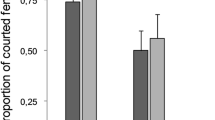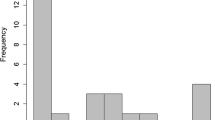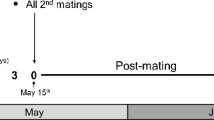Abstract
Sperm competition will be the inevitable consequence of polyandrous mating behavior if two or more males inseminate a single female. It has been demonstrated for a wide variety of animals that males adapt to this situation behaviorally, physiologically and morphologically, e.g. by evolving relatively large testes size to produce more sperm. All pair-living primates investigated so far were found to have relatively small testes, suggesting a monandrous mating system. We investigated the relationship between extra-pair paternity (EPP) rate as a measure of sperm competition intensity and relative testes size in a pair-living primate, the fork-marked lemur (Phaner furcifer). Paternity exclusion analyses for seven offspring using six polymorphic DNA-microsatellite markers suggested a high EPP rate. Female nocturnal travel distances were longer during the mating season, suggesting that females take an active role in achieving extra-pair copulations (EPCs). Surprisingly, fork-marked lemur testes size was relatively small compared to 23 other lemuroid primates, a result that is in contrast to predictions of sperm competition theory. Neither possible behavioral and morphological adaptations to an alternative paternity guard (i.e. mate guarding), nor sampling biases, phylogenetic constraints, and population density effects explain the absence of large testes in a species with high EPP, a phenomenon also known from birds with moderate to low EPP rates. We conclude that more data are needed on the frequency of EPCs, the timing of in-pair and extra-pair copulations, as well as the role of female choice, to explain why males of some species apparently do not adapt to sperm competition.



Similar content being viewed by others
References
Altmann J (1974) Observational study of behavior: sampling methods. Behaviour 39:193–267
Anzenberger G (1992) Monogamous social systems and paternity in primates. In: Martin RD, Dixson AF, Wickings EJ (eds) Paternity in primates: genetic tests and theories. Karger, Basel, pp 203–224
Ausilio E, Raveloanrinoro G (1998) Les lémuriens de la région de Bemaraha: forêts de Tsimembo, de l’Antsingy et de la région Tsiandro. Lemur News 3:4–7
Barber CA, Robertson RJ, Boag PT (1996) The high frequency of extra-pair paternity in the tree-swallow is not an artefact of nestboxes. Behav Ecol Sociobiol 38:425–430
Birkhead TR, Kappeler PM (2003) Post-copulatory sexual selection in birds and mammals. In: Kappeler PM, van Schaik CP (eds) Sexual selection in primates. Cambridge University Press, Cambridge
Birkhead TR, Møller AP (1992) Sperm competition in birds: evolutionary causes and consequences. Academic, London
Birkhead TR, Møller AP (1993) Female control of paternity. TREE 8:100–104
Brotherton PNM, Pemberton JM, Komers PE, Malarky G (1997) Genetic and behavioural evidence for monogamy in a mammal Kirk’s dik-dik (Madoqua kirkii). Proc R Soc Lond B 164:675–681
Bull CM, Cooper SJB, Baghurst BC (1998) Social monogamy and extra-pair fertilization in an Australian lizard Tiliqua rugosa. Behav Ecol Sociobiol 44:63–72
Clutton-Brock TH, Parker GA (1995) Punishment in animal societies. Nature 373:209–219
Darwin C (1871) The descent of man, and selection in relation to sex. Murray, London
Davies NB, Hartley LR, Hatchwell BJ, Langmore NE (1996) Female control of copulations to maximize male help: a comparison of polygynandrous alpine accentors Prunella collaris and dunnocks P. modularis. Anim Behav 51:27–47
DeWoody JA, Fletcher DE, Wilkins SD, Nelson WS, Avise JC (2000) Genetic monogamy and biparental care in an externally fertilizing fish the largemouth brass (Micropterus salmoides). Proc R Soc Lond B 267:2431–2437
Eberle M, Kappeler PM (2002) Mouse lemurs in space and time—a test of the socioecological model. Behav Ecol Sociobiol 51:131–139
Emlen ST, Oring LW (1977) Ecology sexual selection and the evolution of mating systems. Science 197:215–223
Fietz J (1999a) Monogamy as a rule rather than exception in nocturnal lemurs: the case of the fat-tailed dwarf lemur (Cheirogaleus medius). Ethology 105:259–272
Fietz J (1999b) Mating system of Microcebus murinus. Am J Primatol 48:127–133
Fietz J, Zischler H, Schwiegk C, Tomiuk J, Dausmann KH, Ganzhorn JU (2000) High rates of extra-pair young in the pair-living fat-tailed dwarf lemur Cheirogaleus medius. Behav Ecol Sociobiol 49:8–17
Ganzhorn JU, Kappeler (1996) Lemurs of the Kirindy Forest. Primate Rep 46:257–274
Ganzhorn JU, Sorg J-P (1996) Ecology and economy of a tropical dry forest in Madagascar. Primate Rep 46:1–382
Girman DJ, Mills MGL, Geffen E, Wayne RK (1997) A molecular genetic analysis of social structure dispersal and interpack relationships of the african wild dog (Lycaon pictus). Behav Ecol Sociobiol 40:187–198
Goossens B, Graziani L, Waits LP, Farand E, Magnolon S, Coulon J, Bel M-C, Taberlet P, Allainé D (1998) Extra-pair paternity in the monogamous alpine marmot revealed by nuclear DNA microsatellite analysis. Behav Ecol Sociobiol 43:281–288
Gowaty PA (1996) Battles of the sexes and origins of monogamy. In: Black JM (ed) Partnership in birds—the study of monogamy. Oxford University Press, Oxford, pp 21–52
Grafen A (1980) Opportunity cost benefit and the degree of relatedness. Anim Behav 28:967–968
Haggerty TM, Morton ES, Fleischer RC (2001) Genetic monogamy in carolina wrens (Thryothorus ludovicianus). Auk 118:215–219
Hapke A, Eberle M, Zischler H (2003a) Isolation of new microsatellite markers and application in four species of mouse lemurs (Microcebus sp). Mol Ecol Notes 3:205–208
Hapke A, Schülke O, Zischler H (2003b) Microsatellite markers for paternity testing in fork-marked lemurs (Phaner furcifer). Mol Ecol Notes 3:438–440
Harcourt AH, Harvey PH, Larson SG, Short R (1981) Testis weight body weight and breeding system in primates. Nature 293:55–56
Harvey PH, Harcourt AH (1984) Sperm competition, testes size, and breeding systems in primates. In: Smith RL (ed) Sperm competition and the evolution of animal mating systems. Academic, San Diego, pp 589–600
Heller KG, Achmann R, Witt K (1993) Monogamy in the bat Rhinolophus sedulus? Z Säugetierkde 58:376–377
Johnson S, Gordon A, Stumpf R (2002) Sexual dimorphism and testicle size in white-collared lemurs (Eulemur albocollaris). Am J Phys Anthropol 117:90–91
Jones AG, Kvarnemo C, Moore GI, Simmons LW, Avise JC (1998) Microsatellite evidence for monogamy and sex-biased recombination in the Western Australian seahorse Hippocampus angustsus. Mol Ecol 7:1497–1505
Jormalainen V, Merilaita S (1995) Female resistance and duration of mate-guarding in three aquatic peracarids (Crustaceae). Behav Ecol Sociobiol 36:43–48
Kappeler PM (1997a) Intrasexual selection and testis size in strepsirrhine primates. Behav Ecol 8:10–19
Kappeler PM (1997b) Intrasexual selection in Mirza coquereli: evidence for scramble competition polygeny in a solitary primate. Behav Ecol Sociobiol 45:115–127
Kappeler PM (1998) Nests, tree holes, and the evolution of primate life histories. Am J Primatol 46:7–33
Kleimann DG (1977) Monogamy in mammals. Q Rev Biol 52:39–69
Kraus C, Heistermann M, Kappeler PM (1999) Physiological suppression of sexual function of subordinate males: a subtle form of intrasexual competition among male sifakas (Propithecus verreauxi)? Physiol Behav 66:855–861
Kvarnemo C, Ahnesjö I (1996) The dynamics of operational sex ratios and competition for mates. TREE 11:404–408
Lifjeld JT, Dunn PO, Westneat DF (1994) Sexual selection by sperm competition in birds: male-male competition or female choice? J Avian Biol 25:244–250
Marshall TC, Slate J, Kruuk LEB, Pemberton JM (1998) Statistical confidence for likelihood-based paternity inference in natural populations. Mol Ecol 7:639–655
Masello JF, Sramkova A, Quillfeldt P, Epplen JT, Lubjuhn T (2002) Genetic monogamy in burrowing parrots Cyanoliseus patagonus? J Avian Biol 33:99–103
Mason WA (1974) Comparative studies of social behavior in Callicebus and Saimiri: behaviour of male-female pairs. Folia Primatol 22:1–8
Michalek KG, Winkler H (2001) Parental care and parentage in monogamous great spotted woodpeckers (Picoides major) and middle spotted woodpeckers (Picoides medius). Behaviour 138:1259–1285
Mohr CO (1947) Table of equivalent populations of North American small mammals. Am Midl Nat 37:223–249
Møller AP (1988) Testis size, ejaculate quality, and sperm competition in birds. Biol J Linn Soc 33:273–283
Møller AP (1989) Ejaculate quality, testes size and sperm competition in mammals. Funct Ecol 3:91–96
Møller AP (1991) Sperm competition, sperm depletion, paternal care, and relative testis size in birds. Am Nat 137:882–906
Møller AP, Birkhead TR (1991) Frequent copulations and mate guarding as alternative paternity guards. Behaviour 118:170–186
Møller AP, Briskie JV (1995) Extra-pair paternity, sperm competition and the evolution of testes size in birds. Behav Ecol Sociobiol 36:357–365
Møller AP, Ninni P (1998) Sperm competition and sexual selection: a meta-analysis of paternity studies in birds. Behav Ecol Sociobiol 43:345–358
Moreno J, Boto L, Fargallo JA, de Leon A, Potti J (2000) Absence of extra-pair fertilizations in the chinstrap penguin Pygoscelis antarctica. J Avian Biol 31:580–583
Müller AE, Thalmann U (2000) Origin and evolution of primate social organisation: a reconstruction. Biol Rev 75:405–435
Müller W, Epplen JT, Lubjuhn T (2001) Genetic paternity analyses in little owls (Athene noctua): does the high rate of paternal care select against extra-pair young? J Ornithol 142:195–203
Nievergelt CM, Digby LJ, Ramakrishna U, Woodruff DS (2002) Genetic analysis of group composition and breeding system in a wild common marmoset (Callithrix jacchus) population. Int J Primatol 21:1–20
Oka T, Takenaka O (2001) Wild gibbons’s parentage tested by non-invasive sampling and PCR-amplified polymorphic microsatellites. Primates 42:67–73
Parker GA (1970) Sperm competition and its evolutionary consequences in the insects. Biol Rev 45:525–567
Pereira ME (1991) Asynchrony within estrous synchrony among ringtailed lemurs (Primates: Lemuridae). Physiol Behav 49:47–52
Petter-Rousseaux A (1964) Reproductive physiology and behavior of the lemuroidea. In: Buettner-Janusch J (ed) Evolutionary and genetic biology of primates. Academic, New York, pp 91–132
Pochron ST, Wright PC (2002) Dynamics of testes size compensates for variation in male body size. Evol Ecol Res 4:577–585
Powzyk JA (1997) The socio-ecology of two sympatric indrids: Propithecus diadema diadema and Indri indri. A comparison of feeding strategies and their possible repercussions on species-specific behaviors. PhD Thesis, Duke University
Radespiel U, Del Secco V, Drögemüller C, Braune P, Labes E, Zimmermann E (2002) Sexual selection, multiple mating and paternity in grey mouse lemurs, Microcebus murinus. Anim Behav 63:259–268
Reichert KE, Heistermann M, Hodges JK, Boesch C, Hohmann G (2002) What females tell males about their reproductive status: are morphological and behavioural cues reliable signals of ovulation in bonobos (Pan paniscus)? Ethology 108:583–600
Ribble DO (1991) The monogamous mating system of Peromyscus californicus as revealed by DNA fingerprinting. Behav Ecol Sociobiol 29:161–166
Rooney SM, Wolfe A, Hayden TJ (1998) Autocorrelational data in telemetry studies: time to independence and the problem of behavioural effects. Mammal Rev 27:89–98
Schaik CP van, Dunbar RIM (1990) The evolution of monogamy in large primates: a new hypothesis and some crucial tests. Behaviour 115:30–62
Schaik CP van, Kappeler PM (2003) The evolution of pair living in primates. In: Reichard U, Boesch C (eds) Monogamy: partnership in birds humans and other mammals. University of Cambridge Press, Cambridge
Schmid J, Kappeler PM (1998) Fluctuating sexual dimorphism and hibernation by sex in a primate, the gray mouse lemur (Microcebus murinus). Behav Ecol Sociobiol 43:125–132
Schülke O (2003a) Living apart together—patterns, ecological basis, and reproductive consequences of life in dispersed pairs of fork-marked lemurs (Phaner furcifer, Primates). PhD Thesis, Würzburg. http://opus.bibliothek.uni-wuerzburg.de/opus/volltexte/2003/502/
Schülke O (2003b) The life history of Phaner furcifer. In: Goodman SM, Benstead JP (eds) The natural history of Madagascar. Chicago University Press, Chicago
Schülke O (2003c) To breed or not to breed: food competition and other factors influencing female reproductive decisions in pair-living nocturnal fork-marked lemurs (Phaner furcifer). Behav Ecol Sociobiol 55:11–21
Schülke O, Kappeler PM (2003) So near and yet so far: territorial pairs but low cohesion between pair-partners in a nocturnal lemur Phaner furcifer. Anim Behav 65:331–343
Schwab D (2000) A preliminary study of spatial distribution and mating system of pygmy mouse lemurs (Microcebus cf myoxinus). Am J Primatol 51:41–60
Short RV (1979) Sexual selection and its component parts, somatic and genital selection as illustrated by man and the great apes. Adv Stud Behav 9:131–158
Sommer S, Tichy H (1999) Major histocompatibility complex (MHC) class II polymorphism and paternity in the monogamous Hypogeomy antimena the endagered largest endemic Malagasy rodent. Mol Ecol 8:1259–1272
Stanback M, Richardson DS, Boix-Hinzen C, Mendelson J (2002) Genetic monogamy in Monteiro’s hornbill Tockus monteiri. Anim Behav 63:787–793
Stanger KF, Coffmann BS, Izard MK (1995) Reproduction in Coquerel’s dwarf lemur (Mirza coquereli). Am J Primatol 36:223–237
Westneat DF, Sherman PW (1997) Density and extra-pair fertilizations in birds: a comparative analysis. Behav Ecol Sociobiol 41:205–215
Wolff JO, Dunlap AS (2002) Multi-male mating probability of conception and litter size in the prairie vole (Microtus ochrogaster). Behav Proc 57:105–110
Zinner D, Ostner J, Dill A, Razafimanantsoa L, Rasoloarison R (2001) Results of a reconnaissance expedition in the western dry forests between Morondava and Morombe. Lemur News 6:16–18
Acknowledgements
The study is part of the dissertation work of O.Schülke presented to the University of Würzburg. We thank the Commission Tripartite of the Malagasy Government, the Direction des Eaux et Forêts Madagascar for research permits, the Centre de Formation Professionelle Forestiére de Morondava for hospitality and Professor B. Rakotosamimanana from the Université d’Antananarivo and Felix Rakotondraparany at PBZT Antananarivo for their co-operation. R. Rasoloarison and L. Razafimanantsoa provided invaluable logistic support. We gratefully acknowledge the help of Jean-Claude from Beroboka, Alpha from Marofandilia and many fellow researchers at Kirindy during capture sessions—without them the study would have been impossible. We thank B. Bradley, A. Gordon, N. Hagenah, R. Hilgartner, S. Johnson, R. Kitko, R. Lewis, A. Merenlender, L. Nash, D. Overdorff, U. Radespiel, B. Randrianambinina, R. Stumpf, E. Zimmermann, and D. Zinner for providing us with previously unpublished data. R. Hilgartner, M. Port, A. Perez-Mélis and T. Adrianjanahary contributed with their observations. A. Hapke introduced O.S. to the genetics laboratory and J. Fietz, A. Hapke and M. Eberle shared their DNA primers with us. We thank S. Alberts, C. Borries, A. Koenig, J. Ostner and D. Zinner for discussion and/or helpful comments. Financial support was generously provided by Deutsches Primatenzentrum Göttingen. The study complies with the current laws of the countries where it was conducted.
Author information
Authors and Affiliations
Corresponding author
Additional information
Communicated by S. Alberts
Rights and permissions
About this article
Cite this article
Schülke, O., Kappeler, P.M. & Zischler, H. Small testes size despite high extra-pair paternity in the pair-living nocturnal primate Phaner furcifer . Behav Ecol Sociobiol 55, 293–301 (2004). https://doi.org/10.1007/s00265-003-0709-x
Received:
Revised:
Accepted:
Published:
Issue Date:
DOI: https://doi.org/10.1007/s00265-003-0709-x




